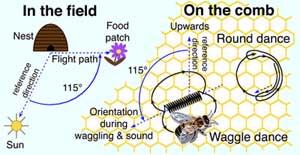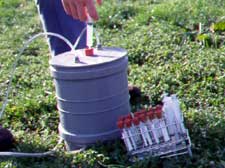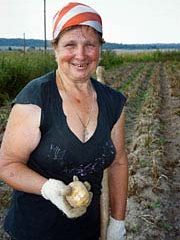Agricultural and Forestry Science

UC Riverside entomologists report bee-dancing brings more food to honeybee colonies
Honeybees communicate by dancing. The dances tell worker bees where to find nectar. A UC Riverside study reports that under natural foraging conditions the communication of distance and direction in the dance language can increase the food collection of honeybee colonies. The study also confirms that bees use this directional information in locating the food sources advertised in the dance.
Based on work done in 2001 in the Agricultural Experiment Station at UC Riverside, P. Kirk Visscher,

Environmental impact of fertilisers on agriculture
The problem is intensive agriculture. Nowadays, some farmers have too many heads of cattle in comparison with their land under tillage. Due to this, purines (manure and stable/barn droppings) are applied in high concentrations on these soils, above all on those around the barns. Also, in order to feed the land which is further afield, farmers buy mineral feeds. Great problems for the environment arise out of the application of high quantities of mineral fertilisers and purines.
The Departmen

Stung by success: Intensive farming may suppress pollinating bees
Study shows native bee species provide valuable services when allowed to flourish
Intensive, industrial-scale farming may be damaging one of the very natural resources that successful crops require: pollinating bees. A study by Princeton scientists found that native bee populations decline dramatically as agricultural intensity goes up.
In farms studied in and around the Sacramento Valley in California, concentrated farming appeared to reduce bee populations by eliminating natura

Scientists Find New Way to Assess Where Cotton-Killing Pests Develop
In a finding that could have broad implications for farmers’ ability to stop pests from decimating cotton crops, scientists from North Carolina State University and agricultural research stations in the Cotton Belt have developed a new technique to determine where the larvae of certain agricultural pests develop.
The study, which looks at the characteristics of the moths that the larvae turn into, shows that a large majority of late-season moths in the Cotton Belt – specifically Helico

Canadian scientists develop first-ever Fusarium-tolerant pastry wheat
Eastern Canadian producers can now benefit from a new wheat cultivar with increased tolerance to Fusarium head blight, a fungal disease which has cost the Canadian agri-food industry hundreds of millions of dollars.
The new line, a soft red winter wheat often used for pastries, exhibits nearly four-times fewer mycotoxins when exposed to the fungus, than other wheat varieties on the market. The level of mycotoxins present in wheat can greatly affect yields, as well as grade and market value.

Examining a disease decimating global potato yields
While many Americans will be relaxing after their Thanksgiving Day feast, many people around the world may have a shortage of food, particularly potatoes, a staple that is being seriously threatened by a disease called potato late blight.
In a news story appearing in the journal Science (Nov. 29), “Taking the Bite Out of Blight,” writer Glenn Garelik examines the disease that is affecting potato production globally.
Potato late blight (Phytophthora infestans ) is the pathogen tha